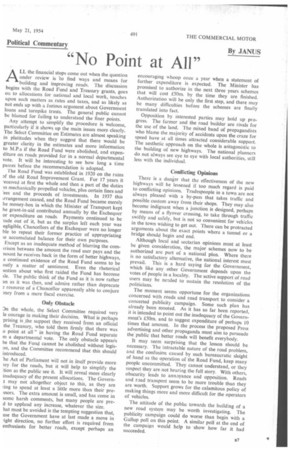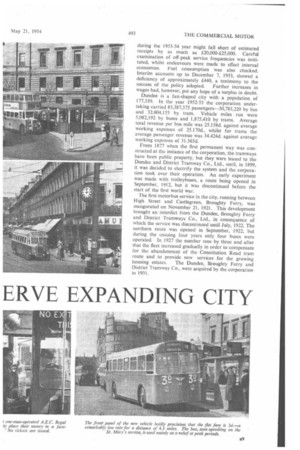"No Point at All"
Page 41

Page 43

If you've noticed an error in this article please click here to report it so we can fix it.
ALL the financial stops come out when the question under review is lo find ways and means for building and improving roads. The discussion begins with the Road Fund and Treasury grants, goes on to allocations for national and local work, touches upon such matters as rates and taxes, and as likely as not ends up with a furious argument about Government loans and turnpike trusts. The general public cannot be blamed for failing to understand the finer points.
* Any attempt to simplify the procedure is welcome, particularly if it shows up the main issues more clearly. The Select Committee on Estimates are almost speaking in platitudes when they suggest that there would be greater clarity in the estimates and more information to 1VI.P.s if the Road Fund were abolished, and expenditure on roads provided for in a normal departmental vote. It will be interesting to see how long a time passes before the recommendation is adopted.
The Road Fund was established in 1920 on the ruins af the old Road Improvement Grant. For 17 years it -eceived at first the whole and then a part of the duties xi mechanically propelled vehicles, plus certain fines and 'ees and the proceeds of investments. In 1937 this irrangement ceased, and the Road Fund became merely he money-box in which the Minister of Transport kept he grant-in-aid contributed annually by the Exchequer or expenditure on roads. Payments continued to be lade out of it, but as the surplus left each year was egligible, Chancellors of the Exchequer were no longer ble to repeat their former practice of appropriating ie accumulated balance for their own purposes.
Except as an inadequate method of blurring the cornIrison between the amount the road user pays and the nount he receives back in the form of better highways, e continued existence of the Road Fund seems to be ostly a matter of sentiment. Even the rhetorical iestion about who first raided the Fund has become tie. The public think of the Fund as it is now rather an as it was then, and admire rather than deprecate a resource of a Chancellor apparently able to conjure )ney from a mere fiscal exercise.
Only Obstacle
Dn the whole, the Select Committee required very le courage in making their decision. What is perhaps prising is „the support they received from an official the Treasury, who told them firmly that there was o point at all" in having the Road Fund separate in a departmental vote. The only obstacle appears be that the Fund cannot be abolished without Iegison. and the Committee recommend that this should introduced.
he Act of Parliament will not in itself provide more tey for the roads, but it will help to simplify the lion as the public see it. It will reveal more clearly inadequacy of the present allocations. The Govern.t may not altogether object to this, as they are ring to spend at least a little more than their pressors. The extra amount is small, and has come in some harsh comments, but many people are pre. d to applaud any increase, whatever the size.
hat must be avoided is the tempting suggestion that, use the Government have at last made a move in -ight direction, no further effort is required from enthusiasts for better roads, except perhaps an
encouraging whoop once a year when a statement of further expenditure is expected. The Minister has promised to authorize in the next three years schemes that will cost £50m. by the time they are finished. Authorization will be only the first step, and there may be many difficulties before the schemes are finally translated into fact.
Opposition by interested parties may hold up progress. The farmer and the road builder are rivals for the use of the land. The mixed band of propagandists who blame the majority of accidents upon the craze for speed have at all times attracted considerable support. The aesthetic approach on the whole is antagonistic to the building of new highways. The national planners do not always see eye to eye with local authorities, still less with the individual.
Conflicting Opinions
There is a danier that the effectiveness of the new highways will be lessened if too much regard is paid to conflicting opinions. Tradespeople in a town are not always pleased with a by-pass that takes traffic and possible custom away from their shops. They may also become indignant when a junction is designed, perhaps by means of a flyover crossing, to take through traffic swiftly and safely, but is not so convenient for vehicles in the town wishing to get out. There can be protracted arguments about the exact points where a tunnel or a bridge should begin and end.
Although local and sectarian opinions must at least be given consideration, the major schemes now to be authorized are part of a national plan. Where there is no satisfactory alternative, the national interest must prevail. This is a hard saying for the Government, which like any other Government depends upon the votes of people in a locality. The active support of road users may be needed to sustain the resolution of the politicians.
The moment seems opportune for the organizations concerned with roads and road transport to consider a concerted publicity campaign. Some such plan has already been mooted. As it has so far been reported, it is intended to point out the inadequacy of the Government's £50m. and to suggest expenditure of perhaps 10 times that amount. In the process the proposed Press advertising and other propaganda must aim to persuade the public that better roads will benefit everybody.
It may seem surprising that the lesson should be necessary. The intractable nature of the road problem, and the confusion caused by such bureaucratic sleight of hand as the operation of the Road Fund, keep many people uncommitted. They cannot understand, or they suspect they are not hearing the full story. With others, obscurity leads to annayance and opposition. Roads and r3ad transport seem to be more trouble than they are worth. Support grows for the calamitous policy of making things more and more difficult for the operators of vehicles.
The attitude of the public towards the building of a new road system may be worth investigating. The publicity campaign could do worse than begin with a Gallup poll on this point. A similar poll at the end of the campaign would help to show how far it had succeeded. during the 1953-54 year might fall short of estimated receipts by as much as £20,000-£25,000. Careful examination of off-peak service frequencies was instituted, whilst endeavours were made to effect internal economies. Fuel consumption was also checked. Interim accounts up to December 7, 1953, showed a deficiency of approximately £440, a testimony to the success of the policy adopted. Further increases in wages had, however, put any hope of a surplus in doubt.
Dundee is a fan-shaped city with a population of 177,330. In the year 1952-53 the corporation undertaking carried 83,387,375 passengers-50,783,220 by bus and 32,604,155 by tram. Vehicle miles run were 5,082,192 by buses and 1,875,410 by trams. Average total revenue per bus mile was 25.158d. against average working expenses of 25.170d., whilst for trams the average passenger revenue was 34.424d. against average working expenses of 31.365d.
From 1877 when the first permanent way was constructed at the instance of the corporation, the tramways have been public property, but they were leased to the Dundee and District Tramway Co., Ltd., until, in 1899, it was decided to electrify the system and the corporation took over their operation. An early experiment was made with trolleybuses, a route being opened in September, 1912, but it was discontinued before the start of the first world war.
The first motorbus service in the city, running between High Street and Castlegreen, Broughty Ferry, was inaugurated on November 21, 1921. This development brought an interdict from the Dundee, Broughty Ferry and District Tramways Co., Ltd., in consequence of which the service was discontinued until July, 1922. The northern route was opened in September, 1922, but during the ensuing four years only four buses were operated. In 1927 the number rose by three and after that the fleet increased gradually in order to compensate for the abandonment of the Constitution Road tram route and to provide new services for the growing housing estates. The Dundee, Broughty Ferry and District Tramway Co., were acquired by the corporation in 1931.




















































































